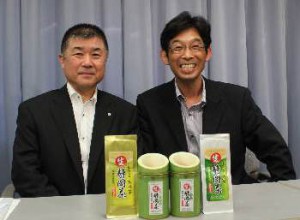
Hitoshi Mizoshita, head of JA Oigawa’s tea industry center (left), and EBISTRADE President Ryoji Terai show the green tea products developed for the Russian market at the Shizuoka prefectural office.
OIGAWA, Shizuoka Prefecture – An agricultural cooperative in Oigawa, Shizuoka prefecture (JA Oigawa), and EBISTRADE Inc., a Tokyo-based trading firm, will jointly start exporting Shizuoka-grown green tea to Russia, seeing potential in the market with many tea lovers.
They will begin with shipping a ton of green tea, and start selling them in Vladivostok through an affiliated firm from the end of July. As green tea is gaining popularity in Russia as a healthy drink, they hope to ship 1,000 ton annually and post annual sales of 15 billion yen by fiscal 2017.
Hitoshi Mizoshita, head of JA Oigawa’s Kawane tea industry center, said that since the domestic market for leaf teas has been sluggish, they hope to find a way out by seeking potential demand in the Russian market.
Green tea to be exported to Russia is produced in Shizuoka, a premier green tea growing region. The product comes in two types; sencha green tea with maccha powder and sencha green tea mixed with roasted brown rice, pop rice and maccha powder. They come in cans resembling bamboos or plastic packages. Maccha is added to brighten the greenness of the products to give them a high-quality look which differentiates them from other products.
According to EBISTRADE, Russia is the world’s third largest tea consumption country in terms of total volume, with annual consumption of 170,000 tons, but the nation depends totally on imports as it does not produce tea domestically. Tea consumed in Russia is mainly black tea, but the market share of green tea has increased to roughly 10 percent thanks to the recent health boom.
However, since most of green tea imports are from China, EBISTRADE plans to publicize the high quality of Japanese green tea and hopes to sell the products in some 1,500 supermarkets and drugstores in Russia in the future.
EBISTRADE President Ryoji Terai said that green tea normally sold in Russia is reddish in color like fermented or half-fermented tea, and differs from Japanese green tea. Terai said they hope to spread the Japanese-style green tea in Russia, adding that they are targeting markets between commonly distributed products and high-end products.
Japan’s green tea exports are recently showing a large increase, backed by a global trend toward healthy eating. In 2012, the exports rose 7.2% from the previous year to a record high of around 5 billion yen. In terms of importing countries, the United States topped the list, importing nearly half of the total volume, followed by Singapore and Germany. Russia’s imports of Japanese green tea in 2012 was as small as 2.73 million yen, but experts pay attention to Russia as a potential market, as its tea consumption is large.
(July 11, 2013)

